Tags
The hierarchy of early 1960’s Seikomatic movements follows a path from the base 17 jewel calendarless 603 (the 20 jewel version features in the classic Seikomatic Silverwave), via the 24 jewel 394 self-dater (later becoming the 6205) and the 33 jewel 400 weekdater movements (latterly in slightly downgraded form appearing as the 6206) to, at the top of the pile, the 39 jewel 395, veritably brimming with an embarrassment of riches in the jewelling department. When last we met this movement, it was being used as the basis of a hot-rodded 62MAS but, in spite of my pedigree as a scientist and mathematician of sorts, I found myself roundly failing to achieve anything more than 33 in my attempts to count to 39. A bit of research suggested that the missing 6 jewels should have been located within the bearings of the autowinder mechanism, although it was unclear whether the bearings themselves would have been ruby or whether the additional jeweling was hidden within ball-bearing housing. Either way, the movement I had at my disposal at the time sported steel ball bearings with no evidence at all to suggest that those 6 jewels had been secreted somewhere out of view. That little mystery has niggled at me since and so I found myself acquiring a second 395 with the aim of putting together a complete and correct watch, one hopefully living up to the claims on the dial.
The first watch whose 395 I farmed for use in my 62MAS had a pretty decent dial and handset and finds itself now paired with a brother whose dial and chapter ring are in rather more of a sorry state, the lacquer peeling away from the edges of the dial and the chapter ring badly discoloured.
 You’ll notice that the dials indicate that these watches would originally have been water proof to 50 m, a feat achieved in part by virtue of their 10 sided polygonal screw down case backs.
You’ll notice that the dials indicate that these watches would originally have been water proof to 50 m, a feat achieved in part by virtue of their 10 sided polygonal screw down case backs.
 A closer look at the case back, and we can just make out the dolphin and king’s crown symbol, indicating this to be the highest-end waterproof Seikomatic of the time, as well as the model number, J13085.
A closer look at the case back, and we can just make out the dolphin and king’s crown symbol, indicating this to be the highest-end waterproof Seikomatic of the time, as well as the model number, J13085.
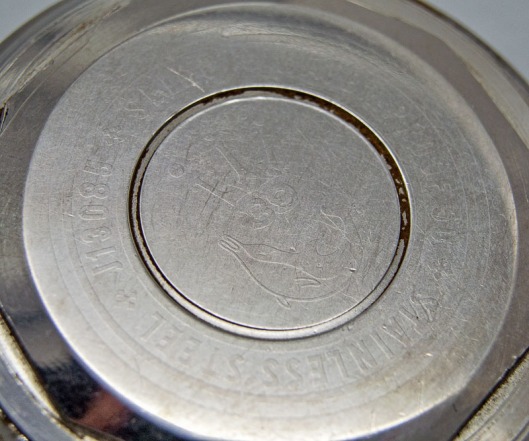 No serial number though, so perhaps this is to be found on the inside of the case back.
No serial number though, so perhaps this is to be found on the inside of the case back.
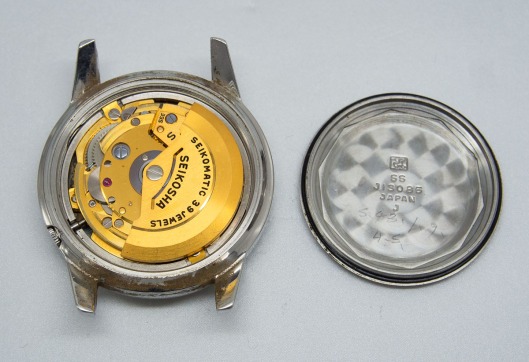 Evidently not, just a repetition of the model number but removing the winding weight reveals what appears to be a serial number on the autowinding mechanism.
Evidently not, just a repetition of the model number but removing the winding weight reveals what appears to be a serial number on the autowinding mechanism.
 The fact that it starts with a 3 would suggest that this watch is from 1963 which is consistent with the fact that production of this model is known to have commenced in May 1963.
The fact that it starts with a 3 would suggest that this watch is from 1963 which is consistent with the fact that production of this model is known to have commenced in May 1963.
So, the idea with this project is to pair the movement and case from the more recently acquired watch with the much better dial, handset and chapter ring from the earlier watch. The wisdom of this approach can be better appreciated by comparing the donor dial on the left (below) which, while a touch grubby, is basically in nice condition, with the dial from the more recent watch (right) which would not be half bad were it not for the fact that the lacquer is lifting around most of its perimeter.
 A clue to why the lacquer might have lifted is gleaned once the dial and hands are removed:
A clue to why the lacquer might have lifted is gleaned once the dial and hands are removed:
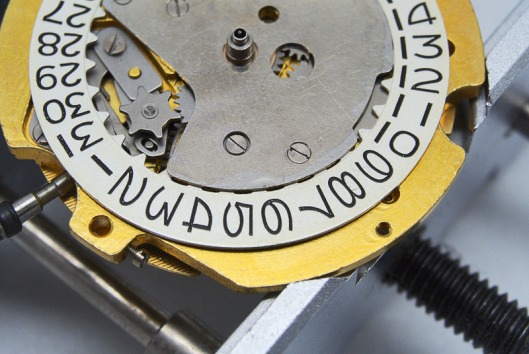 The movement, whilst not exactly swimming in oil, is certainly suffering from a very large excess of the stuff, clearly pooling around the upper edge of the date dial guard as well as the underside.
The movement, whilst not exactly swimming in oil, is certainly suffering from a very large excess of the stuff, clearly pooling around the upper edge of the date dial guard as well as the underside.
 Anyone lubricating a watch movement in this fashion either knows nothing about the workings of a mechanical watch or perhaps prefers the more is more approach to reviving a sluggishly performing watch. Even with my somewhat sedate turnover in projects compared to a professional watchmaker, I come across this sort of slapdashery on rather too frequent a basis.
Anyone lubricating a watch movement in this fashion either knows nothing about the workings of a mechanical watch or perhaps prefers the more is more approach to reviving a sluggishly performing watch. Even with my somewhat sedate turnover in projects compared to a professional watchmaker, I come across this sort of slapdashery on rather too frequent a basis.
Anyway, in spite of this, with the date ring and guard removed, the calendar side looks very tidy indeed, everything present and correct including 9 semi-redundant jewels, there supposedly to ease the passage of the date wheel.
 The reverse side of the movement is equally saturated in oil, pooling along the outer edge of the barrel and train wheel bridge
The reverse side of the movement is equally saturated in oil, pooling along the outer edge of the barrel and train wheel bridge
 and evidently also having contaminated the balance hair spring, whose coils are stuck together.
and evidently also having contaminated the balance hair spring, whose coils are stuck together.
 Other than over-oiling, the only other point of note during the disassembly is the extent to which mainspring grease has leeched from the barrel, contaminating the main plate and lower side of the barrel bridge.
Other than over-oiling, the only other point of note during the disassembly is the extent to which mainspring grease has leeched from the barrel, contaminating the main plate and lower side of the barrel bridge.
 A thorough clean in the ultrasonic bath followed by the watch cleaning machine, and all is spick and span once more.
A thorough clean in the ultrasonic bath followed by the watch cleaning machine, and all is spick and span once more.
 Rebuilding the movement starts as usual with the diafix settings in the main plate and bridge followed by the mainspring. I thought on this occasion, I might take the opportunity to compare the original mainspring (Seiko part number 401610) with a spare Generale Ressorts replacement (GR2533X).
Rebuilding the movement starts as usual with the diafix settings in the main plate and bridge followed by the mainspring. I thought on this occasion, I might take the opportunity to compare the original mainspring (Seiko part number 401610) with a spare Generale Ressorts replacement (GR2533X).
 To my eyes, the GR mainspring (upper) looks a little on the short side and the construction of the braking bridle is clearly different. I have no doubt that the GR would work but given the excellent condition of the original, I opt to reuse that instead of fitting a new, but arguably not quite correct replacement.
To my eyes, the GR mainspring (upper) looks a little on the short side and the construction of the braking bridle is clearly different. I have no doubt that the GR would work but given the excellent condition of the original, I opt to reuse that instead of fitting a new, but arguably not quite correct replacement.
 We seen the nuts and bolts of the reassembly of this movement design several times before and so I’ll hop and skip through the essentials, pausing really just to admire the gorgeous golden sheen of the cleaned movement coming back together
We seen the nuts and bolts of the reassembly of this movement design several times before and so I’ll hop and skip through the essentials, pausing really just to admire the gorgeous golden sheen of the cleaned movement coming back together
 and observe its beating heart once more, power wound into the mainspring, and hairspring unstuck.
and observe its beating heart once more, power wound into the mainspring, and hairspring unstuck.
 Reassembly of the calendar parts on date-only variants of the 62 series movements is complicated only by the precipitous condition one must leave the date jumper spring in whilst locating and refitting the date dial guard. It takes only the merest hint of a suggestion of a butterfly’s flap in the Amazon to persuade the spring to lose its tenuous grip on the jumper and fly off into oblivion. Fortunately on this occasion, that butterfly minds its own business and order is restored. A quick check that the quickset works and the date changes over correctly, and we can refit the dial and hands and turn our attention to the case.
Reassembly of the calendar parts on date-only variants of the 62 series movements is complicated only by the precipitous condition one must leave the date jumper spring in whilst locating and refitting the date dial guard. It takes only the merest hint of a suggestion of a butterfly’s flap in the Amazon to persuade the spring to lose its tenuous grip on the jumper and fly off into oblivion. Fortunately on this occasion, that butterfly minds its own business and order is restored. A quick check that the quickset works and the date changes over correctly, and we can refit the dial and hands and turn our attention to the case.
 With the bezel removed from the case, we see that the acrylic crystal sits on the outside of the case lip, pressed into place by the bezel, rather than using a inner tension ring pushing the crystal against the inside of the case lip. The 50m rating for this case design suggests either approach works effectively although the latter tends to be that most frequently adopted in more modern designs (such as in the 150m rated 62MAS for example).
With the bezel removed from the case, we see that the acrylic crystal sits on the outside of the case lip, pressed into place by the bezel, rather than using a inner tension ring pushing the crystal against the inside of the case lip. The 50m rating for this case design suggests either approach works effectively although the latter tends to be that most frequently adopted in more modern designs (such as in the 150m rated 62MAS for example).
 The chapter ring sits loosely on the inside, a slot in its underside indexing with a tab on the edge of the dial.
The chapter ring sits loosely on the inside, a slot in its underside indexing with a tab on the edge of the dial.
 Most of that deeply unpleasant-looking funk cleans off easily and with the case dried, we can install the chapter ring, a fresh crystal and the bezel
Most of that deeply unpleasant-looking funk cleans off easily and with the case dried, we can install the chapter ring, a fresh crystal and the bezel
 and we are ready to receive the serviced movement.
and we are ready to receive the serviced movement.
 You may have noticed I have dodged the issue thus far of those missing 6 jewels, preferring instead to keep you fidgeting on the edges of your sets for the denouement. The total jewel count contained within the movement without its autowinder is 31 which implies that 8 are located in or about the autowinding mechanism. One of these sits at the axle of the pawl lever, and one services the transmission wheel. So where are the remaining 6? Well, as suspected the six ball bearings in the oscillating weight bearing assembly are ruby rather than steel.
You may have noticed I have dodged the issue thus far of those missing 6 jewels, preferring instead to keep you fidgeting on the edges of your sets for the denouement. The total jewel count contained within the movement without its autowinder is 31 which implies that 8 are located in or about the autowinding mechanism. One of these sits at the axle of the pawl lever, and one services the transmission wheel. So where are the remaining 6? Well, as suspected the six ball bearings in the oscillating weight bearing assembly are ruby rather than steel.
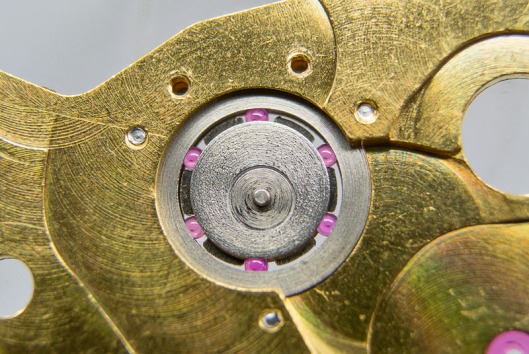 It is tempting to conclude that the use of ruby over steel served little purpose other than to aid the marketing department at the time but here we are in 2016, 53 years after this particular watch rolled off the production line, and those 6 rubies are still present and correct and performing their role.
It is tempting to conclude that the use of ruby over steel served little purpose other than to aid the marketing department at the time but here we are in 2016, 53 years after this particular watch rolled off the production line, and those 6 rubies are still present and correct and performing their role.
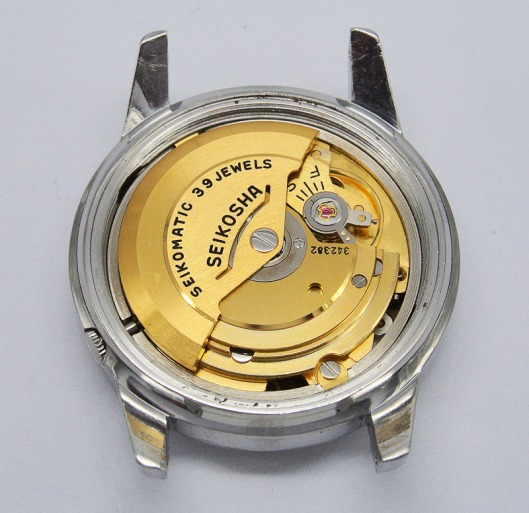 I rather like the idea that a design decision that might on the one hand be regarded as somewhat cynical might equally be viewed simply as extravagant over-engineering.
I rather like the idea that a design decision that might on the one hand be regarded as somewhat cynical might equally be viewed simply as extravagant over-engineering.
39 minus 15 is 24, the same jewel count as the 394/6205B. The essential timekeeping capabilities of the 395 ought to be identical to the 394 but I still really like this watch because, jewel-count not withstanding, it is a simple object of beauty.
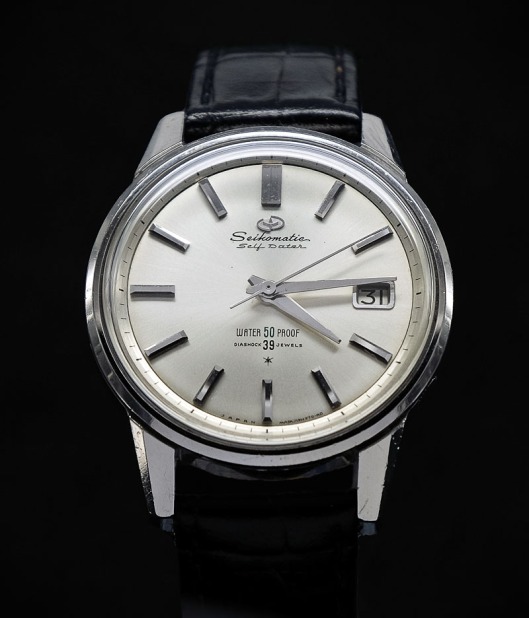
 In 1963, it also served as a statement of intent for the future.
In 1963, it also served as a statement of intent for the future.

Another great job refurbishing that beauty only surpassed by your great presentation as always Martin . I have the same watch but not knowing which crystal to use as a replacement , I sanded and polished mine . Can you please tell me which crystal you used as a replacement ?
Thanks , Louis
Hi Louis, many thanks for your comment. After a bit of detective work, I figured out that the crystal is 338W01AN, the same I think as used in the 6206-8990. They seem to still be in reasonably plentiful supply.
Martin
Aloha Martin , I left a comment but did not see it posted after I clicked the button to leave it . I have the same watch but did not know which crystal to get as a replacement ,…not knowing the case number . I ended up sanding and polishing mine . Can you please tell me which crystal you used as a replacement ?
Thanks , Louis
Hi Louis, the comments await my moderation before appearing and you will have made yours when I was still asleep! Anyway, both now approved and your question answered above 🙂
Hi! This question has nothing to do with this post so i hope it’s okey anyway,
it’s about the pushers on a Seiko 7015-8000 flyback chrono, i forgot to take a note /photo when i took it apart,
well to the question: in which order are the parts supposed be?
Should i put the gasket in the bottom of the pusher then the washer and spring and put it back in the case?
Or should i put the gasket in the case and then the washer and spring and then put the pusher back?
and of course the circlip from the inside. se pic.se pic.
Thank you in advance and for your nice site.
Regards. Thommy.
Hi Thommy, I’m afraid I’ve not previously worked on one of these flyback chronos (although funnily enough I have one on its way) and am not familiar with the construction of the pushers. I may be able to answer your question when mine arrives but in the meantime, perhaps there are photos or technical documents for your case design somewhere online?
Hi martin, I love your work, you are a fine fettler. Great to get information in relation to historical development and the opportunity of a detailed look at the movement.
I have a seikomatic weekdater 6218 8971 (a) and for me it is an exquisite thing of beauty, a top top design and Seiko at the top of their game.
The external condition is extremely good but it is in need of a service as previous owner informed it has been over 5 years since it has been done. It is running at – 180 sec/24hr and I am hoping that this can be improved after a good clean.
I am at present considering the purchase of a 395 , the chapter ring and crystal would require replacing to show it at it’s best.
Martin can chapter rings for this watch be easily obtained and would I be correct in assuming that the crystal/chapter ring for the 6218 and the 395 are not interchangeable.
Would you be able to recommend who to approach in relation to servicing these movements?
Thanks Martin, take care.
From a burgeoning ” Seiko nut ”
Gilmour.
Hi Gilmour, I am glad to hear you have been enjoying the blog. Seiko seemed to take almost perverse pleasure in ensuring that as few as possible case parts were interchangeable in the 1960’s. Sometimes you will find that items such as chapter rings can be swapped between models where the case style is more or less the same but there are often subtle or not so subtle differences that obstruct such interchange. Faced with a similar conundrum in the past with one of my 6206 Seikomatics, the only way I was able to find a replacement chapter ring was to buy another watch with other issues but which provided the part I needed.
In the case of your specific question, the chapter ring of the 395 and that of your 6218 are not interchangeable. The crystal of the former is pressed into place around its outer diameter by the case bezel whereas that of the latter uses a tension ring to exert the required force around the inner diameter (the 6218 having no separate case bezel. The chapter rings in each then sit quite differently in the cases, dimensions not withstanding.
As to recommendations for servicing, I would suggest either Richard Askham or Duncan Hewitt in the UK or in the USA, perhaps Spencer Klein. Google searches for each with ‘Seiko’ attached should reveal their contact details.
Good luck!
Martin
Interesting piece on watch restoration. I am trying to get a skeleton watch made for me but have had quotes in time and coinage, referring to how long it would take to make, one company said a year!!
I’ve got this very watch on my wrist as I type. I love it & it’s a birth year watch to boot. Very much enjoy your work & write ups
Thanks Rob – glad to hear it!
Lovely article with equally beautiful pics! I have the same watch, and I am currently trying to find out what the lift angle of 395 is. I have a hunch that it is 52, but I would not mind a confirmation on the matter.
I have long lists of lift angles for a wide variety of movements but have never been able to find lift angles for this series of movement. I just use 52 degrees for no better reason than that it is the default for my timegrapher. Sorry!
Hi Martin
Such a pleasure to read your blog!
Is there a fundamental difference between the blue 50 proof and the black 50 proof lettering? Or has the blue faded to black?
Thank you and keep up the great job.
That is a good question, but one whose answer evades me! It could be, as you suggest, just that the colour has changed with age or that Seiko used different colour depending on when the dials were produced.
It is always refreshing to receive comments or questions that had not occurred to me at the time and so thank you for this.
While doing a long overdue basement clean up last month, I found my Seiko 6105-8009 (lost and forgotten 30+ years ago) and my father-in-law’s 39-jewel Seikomatic Self-Dater (probably not worn for 40+ years). Both are in wonderful condition, started running within seconds of being picked up, and have been keeping perfect time ever since. My previous high regard for Seiko quality is now even higher. Given their age, is there any reason to have either or both watches serviced/cleaned by a reputable Seiko watchsmith or can I just enjoy wearing them?
It is wonderful to hear of accounts of the watches from their original owners – thank you. Given the likelyhood that the oils will have degraded and without knowing how dirty the movements are, I would advise you to get them serviced. Even though they appear to be running satisfactorily, a watch timing machine would probably reveal problems that would manifest in the timekeeping. If you do decide to get them serviced, then exercise care in who you choose to do the work and resist any offers to polish cases, renew dials and so on!
I have just purchased a J13085 and eagerly await its delivery for Christmas ! I havent managed to find much other information on it elsewhere, so thank you for posting this insight – a great read
No problem. Glad you found it useful!
My understanding is that the six jewels in the rotor bearing tended to shatter if the watch was dropped; and if the watch was then returned to Seiko for repair, they would all be replaced by steel balls. Over the years, this has happened to most of these watches and so finding one with its original count is quite lucky.
I’ve had two of these, one with the original sapphire bearings and one steel. For me that’s been even odds!
Hi Martin,
Very insightful! I have a question:
When identifying the jewels, did you find one in the canon pinion of fourth wheel?
I’ve found documentation that places 2 jewels in the fourth wheel.
It is normal for the top pivot to have a jewel but typically, they are bushed through the cannon pinion on the bottom. Did these have a jewel in the cannon pinion? This is pretty common with other brands but not often seen on SEIKO.
Best regards,
Chris
Hi Chris, there is a jeweled plate sitting on top of the centre wheel bridge in addition to the jeweled top pivot. You can see this in one of the photos in the article.
Hey mate.
I have three of these and would like some assistance with one if you are able.
My latest 395 silver 39 j self dater rotor bearing has failed. I found this out after removing the case back and the rotor and half the bearing came out. The other half is still in the auto bridge. It looks like I can replace the bearing only. Does this sound right.
Anyway it would be great to hear from you. I want to pair this one with my other gold 70 m 39 j beauty. 😂😂
Rob
The bearing is secured into the bridge by three screws. You should be able to remove the complete bearing and then, if unsalvageable, replace with one farmed from another 62 series movement. You will lose the ruby bearings , assuming they are still there in the original watch, but that won’t affect functionality.
Thanks mate.
I do have a 6206 movement I can scrap this from. As you say I would like the movement to be a solid 38 jewels. 😂😂😂😂
If anyone has a jeweled bearing let me know.
Rob
Hi Martin.
Found your blog via a Google search – I’m considering the same 39 jewels Seikomatic Self Dater but want a 1963 model. The 6 digit number on the Seikosha movement begins 31 – is this right to assume it’s a 1963 watch? I’ve checked on serial number websites and they suggest it’s a 1973, 1983, 1993… 2023 watch – which doesn’t make sense. Is there any way to confirm it’s from 1963?
Enjoying your blog articles now I’ve found it.
Thanks
Nigel
Hi Nigel,
A serial number starting 31 indicates a date of manufacture in this case of January 1963. You can be confident of that because this model was only produced in the early 1960s and probably none later than about 1964. The serial number syntax does not on its own identify the decade – you have to deduce that from the model and in this case there is no abiguity at all. 1963 it is.
All the best
Martin